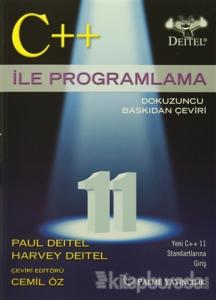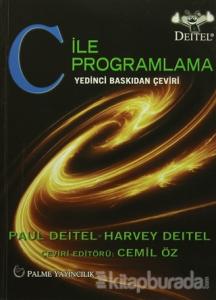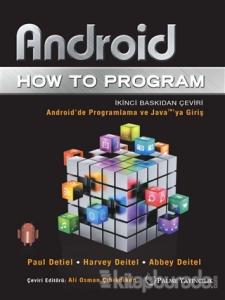
Object-Oriented Programming Early-objects approach.The book introduces the basic concepts and terminology of object technology in Chapter 1. You'll develop your first customized classes and objects in Chapter 3. Presenting objects and classes early gets you “thinking about objects” immediately and mastering these concepts more thoroughly. (For courses that require a late-objects approach, considerC++ How to Program, Late Objects Version, which begins with six chapters on programming fundamentals (including two on control statements) and continues with seven chapters that gradually introduce object-oriented programming concepts.) C++ Standard Library string.C++ offerstwotypes of strings–string class objects (which we begin using in Chapter 3) and C strings. We've replaced most occurrences of C strings with instances of C++ class string to make programs more robust and eliminate many of the security problems of C strings.
We continue to discuss C strings later in the book to prepare you for working with the legacy code that you'll encounter in industry. In new development, you should favor string objects. C++ Standard Library array.Our primary treatment of arrays now uses the Standard Library's array class template instead of built-in, C-style, pointer-based arrays. We still cover built-in arrays because they remain useful in C++ and so that you'll be able to read legacy code. C++ offersthreetypes of arrays–arrays and vectors (which we start using in Chapter 7) and C-style, pointer-based arrays which we discuss in Chapter 8. As appropriate, we use class template array instead of C arrays throughout the book. In new development, you should favor class template array objects. Crafting valuable classes.A key goal of this book is to prepare you to build valuable classes. In the Chapter 10 case study, you'll build your own custom Array class, then in the Chapter 18 exercises you'll convert it to a class template. You'll truly appreciate the class concept. Chapter 10 begins with a test-drive of class template string so you can see an elegant use of operator overloading before you implement your own customized class with overloaded operators.
Case studies in object-oriented programming.We provide case studies that span multiple sections and chapters and cover the software development lifecycle. These include the GradeBook class in Chapters 3—7, the Time class in Chapter 9 and the Employee class in Chapters 11—12. Chapter 12 contains a detailed diagram and explanation of how C++ can implement polymorphism, virtual functions and dynamic binding “under the hood.” Optional case study: Using the UML to develop an object-oriented design and C++ implementation of an ATM.The UML™ (Unified Modeling Language™) is the industry-standard graphical language for modeling object-oriented systems. We introduce the UML in the early chapters. Online Chapters 25 and 26 include anoptionalcase study on object-oriented design using the UML. We design and implement the software for a simple automated teller machine (ATM). We analyze a typical requirements document that specifies the system to be built. We determine the classes needed to implement that system, the attributes the classes need to have, the behaviors the classes need to exhibit and we specify how the classes must interact with one another to meet the system requirements. From the design we produce a complete C++ implementation. Students often report that the case study helps them “tie it all together” and truly understand object orientation. Exception handling.We integrate basic exception handlingearlyin the book. Instructors can easily pull more detailed material forward from Chapter 17, Exception Handling: A Deeper Look. Custom template-based data structures.We provide a rich multi-chapter treatment of data structures–see the Data Structures module in the chapter dependency chart (Fig. 6). Three programming paradigms.We discussstructured programming,object-oriented programmingandgeneric programming.
- Açıklama
Object-Oriented Programming Early-objects approach.The book introduces the basic concepts and terminology of object technology in Chapter 1. You'll develop your first customized classes and objects in Chapter 3. Presenting objects and classes early gets you “thinking about objects” immediately and mastering these concepts more thoroughly. (For courses that require a late-objects approach, considerC++ How to Program, Late Objects Version, which begins with six chapters on programming fundamentals (including two on control statements) and continues with seven chapters that gradually introduce object-oriented programming concepts.) C++ Standard Library string.C++ offerstwotypes of strings–string class objects (which we begin using in Chapter 3) and C strings. We've replaced most occurrences of C strings with instances of C++ class string to make programs more robust and eliminate many of the security problems of C strings.
We continue to discuss C strings later in the book to prepare you for working with the legacy code that you'll encounter in industry. In new development, you should favor string objects. C++ Standard Library array.Our primary treatment of arrays now uses the Standard Library's array class template instead of built-in, C-style, pointer-based arrays. We still cover built-in arrays because they remain useful in C++ and so that you'll be able to read legacy code. C++ offersthreetypes of arrays–arrays and vectors (which we start using in Chapter 7) and C-style, pointer-based arrays which we discuss in Chapter 8. As appropriate, we use class template array instead of C arrays throughout the book. In new development, you should favor class template array objects. Crafting valuable classes.A key goal of this book is to prepare you to build valuable classes. In the Chapter 10 case study, you'll build your own custom Array class, then in the Chapter 18 exercises you'll convert it to a class template. You'll truly appreciate the class concept. Chapter 10 begins with a test-drive of class template string so you can see an elegant use of operator overloading before you implement your own customized class with overloaded operators.
Case studies in object-oriented programming.We provide case studies that span multiple sections and chapters and cover the software development lifecycle. These include the GradeBook class in Chapters 3—7, the Time class in Chapter 9 and the Employee class in Chapters 11—12. Chapter 12 contains a detailed diagram and explanation of how C++ can implement polymorphism, virtual functions and dynamic binding “under the hood.” Optional case study: Using the UML to develop an object-oriented design and C++ implementation of an ATM.The UML™ (Unified Modeling Language™) is the industry-standard graphical language for modeling object-oriented systems. We introduce the UML in the early chapters. Online Chapters 25 and 26 include anoptionalcase study on object-oriented design using the UML. We design and implement the software for a simple automated teller machine (ATM). We analyze a typical requirements document that specifies the system to be built. We determine the classes needed to implement that system, the attributes the classes need to have, the behaviors the classes need to exhibit and we specify how the classes must interact with one another to meet the system requirements. From the design we produce a complete C++ implementation. Students often report that the case study helps them “tie it all together” and truly understand object orientation. Exception handling.We integrate basic exception handlingearlyin the book. Instructors can easily pull more detailed material forward from Chapter 17, Exception Handling: A Deeper Look. Custom template-based data structures.We provide a rich multi-chapter treatment of data structures–see the Data Structures module in the chapter dependency chart (Fig. 6). Three programming paradigms.We discussstructured programming,object-oriented programmingandgeneric programming.
- Yorumlar
- Yorum yazBu kitaba henüz kimse yorum yapmamıştır.




